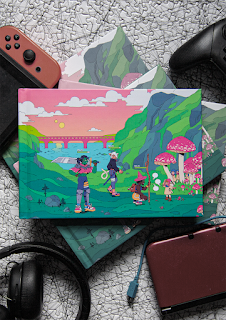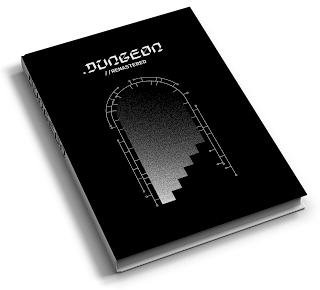The Corrupted by Navaar Seik-Jackson is the adventure game offering of October's Zine Club, but I don't know if I would necessarily call it an "adventure game" if it weren't marketed as such. For me, an adventure should spend most of its time in specifics: maps, NPCs, factions, timelines, antagonists, things that a GM can easily reference and use at the table. In this zine, half of the 32 pages are devoted to the Protagonist System (the engine upon which this game runs), 6 detail game-specific GM advice/mechanics, and 9 deal with the world of The Corrupted. Already, this offering is in a bit of a weird place, but let's spend some time with the provided system to see what it has to offer.
The Protagonist System, per the designer, "draws from traditional systems like Dungeons & Dragons, as well as narrative frameworks like Powered by the Apocalypse games." The influences of these are obvious:
- Use of a d20 for action resolution
- Hit points
- Skill lists
- 6-10 second combat turns
- 6 statistics
- Partial successes/failures
- GM moves
This system is used to explore a post-apocalyptic world (though it offers several flavors of how "post" the apocalypse it is) where an alien pathogen has infected much of life on Earth to create the titular Corrupted, blood-zombies that use inky tendrils to seek out iron-rich deposits and create new Corrupted.
 |
| Picture something like the Corrupted Blood Incident from World of Warcraft, except if all these skeletons were blood monsters. |
I have...mixed feelings about this offering, but I'll start with what is good.The Good Stuff
The two best parts of the system are:
1. Integration of mixed successes into combat via the damage your attack deals is genuinely very clever. Regular damage on a success (16-19 after modifiers), double damage on a critical (20+), and half damage on a partial success (10-15). It matters what kind of approach you take in combat, as with the right bonuses and some lucky rolling you can minimize the number of failures you get (and completely eliminate the possibility of critical failures, since you have to get a 1 or lower after modifiers). This makes the characters feel competent and well-suited for tasks they are specialized for, but also makes for some difficult decisions should they attempt untrained skills.
2. Threat Points make it easy for the GM to run encounters. They start with a budget based on the number of enemies in a combat, gain more when players roll badly, and spend them to do enemy actions like moving, attacking, or making changes to the environment. Under ideal circumstances, the enemies have a limited range of actions, but bad rolls generate additional Threat Points for the GM to use. This can have a cascading effect within a round, where a bad roll puts a character in a desperate position, the new Threat Points worsen the situation, and everyone else has to decide how best to deal with this. Under other circumstances, this could lead to a death spiral for the whole combat, but Threat Points reset each round. A terrible position at the end of one round of combat is still bad for the players at the start of the next, but the enemies are back at square 0 in terms of their ability to react. Yes, this is up to the randomization effect of dice, but smart approaches and playing to characters' strengths allows them to minimize the damage.
These two parts combined angle the game experience towards highly specialized characters performing surgically precise actions (but otherwise acting fairly desperately) or more general-use characters that operate at a constant low level of risk but rarely in dire straits. These general modes of play feel very true to zombie apocalypse media in general: you either have average folks do their best in a horrific situation or military-level agents wasting enemies in combat but oftentimes struggling to accomplish more social goals like community-building. I would love to play a character of either type.
The...Less Good Stuff
The rest of the system (and zine in general) get in the way of what is good about it. What I reference above are not the only good things in the system, but it could be stripped down to those parts and some connective tissue and work pretty well. There are a lot of components of the rules that I would prefer to just jettison because I see them as adding more cognitive load to everyone at the table than the return I would get from them.
But beyond the specific rules that I might not like, the biggest problem that I have here is that the system gets in the way of my understanding the world of The Corrupted. As I mentioned at the top, there are 9 pages of setting information: 4 pages of bestiary (encompassing 4 types of enemies) and 5 pages on 4 factions you might encounter.
And that's it.
This is just not enough for me to grab onto to run a game in this world! I'm increasingly turning to game texts for details that I couldn't come up with myself, things that can inspire me to create my own stories in a world. And to be clear, the seeds of that are here in this zine. The Corrupted have some really fascinating details (they're searching for sources of iron, they develop and evolve over time, they might be aliens) but it's just not enough. Even the factions presented are fairly basic versions of zombie apocalypse tropes. You've got:
- The troubled community doing its best
- The people trying to figure out what caused the apocalypse and how to fix it
- The evil corporation
- And the paramilitary freaks
Just based off these tropes, I could come up with a lot of the text (or something approximating it) for these factions. But I'll tell you what's there that is really useful...
The Best Stuff
...the Day Zero, One Year, and Five Year timelines!
The "Running the Game" section introduces the idea of these three distinct 'timelines' you can run a game in, each of them featuring different themes, types/amounts of enemies, amount of salvageable material in buildings, that kind of stuff. Day Zero is hectic and chaotic but with plenty of resources available, Year One has clear factions forming and supplies running low, and Year Five has desperation on your heels and formidable foes around every corner.
This is exactly what I want from an adventure: actionable advice that helps me quickly and easily figure out what I need to get a game up and running. I just wish there were more of it, as what we have is pretty good. Each faction contains a brief writeup of what they look like in each timeline, but there's just so much more that could have been done and more specifics that could have been included (a roster of NPCs and how they change over time, for example). As it is, the game provides enough to play through each of these timelines, but you'll have to fill in a lot of the gaps yourself without too much help from the zine itself.
Wrap-Up
As I said in the previous review, I'm not in the business of giving out numerical scores at the end of these, so here's my final take on the game: this game could be good for the kind of play that I like to engage in, but it doesn't bring enough innovative ideas to the table for me to really want to use it. The influence of The Last of Us is clear and explicitly namechecked in the opening pages, but unfortunately, I'm just not sure how much this game has to offer beyond that.











